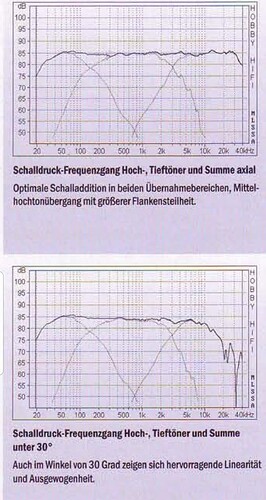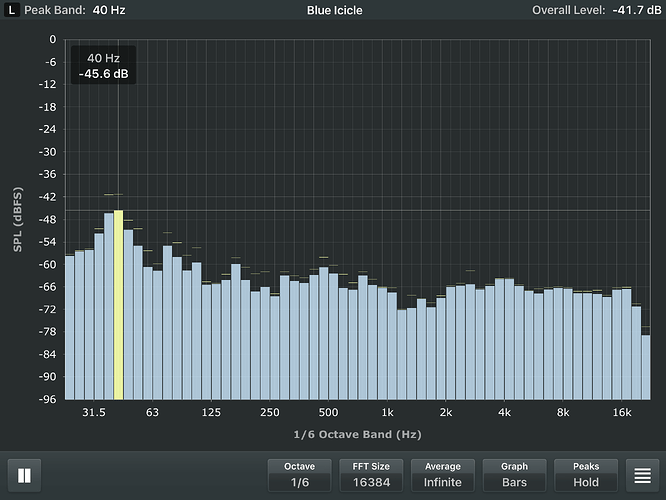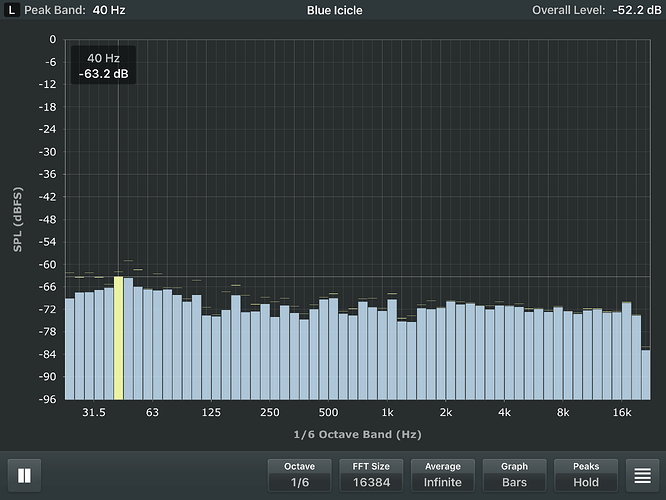Not saying anything about your findings or tests but SR does not recommend using the fuse in a power regenerator. Don’t ask me why obviously it will work but the info I found about the master fuse said source components will benefit the most from the Master fuse.
The listening comparisons are with activated BACCH? I would be more interested in what differences there are without Bacch when the master has broken in for a few hundred hours in order to have a proper comparison with the AM M1. In my system, even with a purple, the sax didn’t sound like a whoopee cushion. There can be many reasons why. I would describe my system as balanced with a slightly warm bloom with high resolution. The Master suits me well. An AM fuse slightly thickens the upper bass for me.
I could always redo the bass DSP. I wanted to assume the Master would be more lively. In all my power cable tests. None have affected overall sound so negatively. Maybe the only comparison is using Iconoclast OFC speaker cables. The blanket over the speakers has returned.
Hi Paul, I’ve had my SR Master in the power station for a long time and it sounded better than the other fuses I’ve used before. Yesterday I took it out of the power station and put it in my DAC/Streamer. It sounds great there too. I now have the Purple from the DAC in the power plant. I notice that an SR master in the source instead of purple has a clearer, sharply ignorant image and more dynamics. The stage is slightly narrower in width than before with the Master in the power plant. But very detailed and clean.
I’d call a P20 a line conditioner.
So you start with a single Master Fuse on your DAC or line conditioner and realize guaranteed results or your money back for the first 30 days. You can then experiment sparingly with additional Master Fuses if you wish to go further. The choice is yours.
I think the warmth factor is killing my sound with this master. I had musical and so far it has ducked it away.
Of course, we were striving for maximum resolution plus the warmth needed for most systems to sound musical.
the Am premier was too much mid bass warmth. The master kils highs and liws It will be interesting reinstalling the M-1. Right now i miss it. Bacch dSP helps everything but the Master Fuse at this point.
The master is still new. Is the comparison with or without artificial influence of DSP and Bacch? If so, have Bacch and DSP been recalibrated to the master? Or do you compare with the settings for the AM and just swap the fuses? From my point of view, a system with DSP is similar to the driver assistance system in a car. You also have to test it pure without ESP and ASC etc.
For me, I had the impression that the master opened up the sound image vertically and horizontally.
Give the master some time and maybe test him in a source. SR says source or power station would be best. In their own test on YouTube it was featured in the Dac.
The measurements are consistent unless you use someone else’s head and ears. My seat is pretty contoured to my head and body so mine are repeatable unless I change acoustics or cables. Even digital cables show measurable difference because of different RF and AeMI capabilities to shield noise.
A racing driver takes a curve at 100 km/h and can do it. The housewife does the same and the assistants help her to keep track. The good system was developed together with the racing driver and reacts in the best case in the same way. Without these systems, the normal driver makes a descent into the green or gravel bed at the same speed. That’s how I imagine a good DSP to be. If the speakers are capable of delivering the tones, it doesn’t really matter how warped the frequency response is. The DSP corrects the frequency. Assuming the DSP, microphone and calibration are free of errors, it should end up sounding the same no matter how bad it sounds without it. Why then other cable components or even fuses? When the same soup comes out at the end ![]()
![]()
Possibly better cables, fuses have a faster responsiveness to insert fewer errors in the smooth ironed representation. But the DSP will always have its limits. If the DSP or the calibration doesn’t give it. Or the microphone adds its mistakes, even a better other component will be of little use. At some point the point is reached where there is no improvement given the limits of the DSP / Bacch.
A good DSP concentrates on removing the room acoustic effects. The best speakers can sound no better than the room. So fix room responses first then do DSP last. DsP sounds bad when you’re adding. The good ones only subtract and not boost frequencies. When you have to boost for equalization the amps run out of headroom and eventually clip or distort.
Okay.
![]()
I have no dog in this hunt, as they say, but there’s still something - maybe just a BACCH question - that I don’t get based on what I’m seeing. Are all of these curves, regardless of what fuse is being used, showing the corrected FR for your listening position? I ask because, well, it doesn’t look corrected. It doesn’t seem to approximate the typically targeted B&K type curve, or even the Harman curve. I’m wondering, as an example, why that nasty looking peak between around 3-5KHz hasn’t been addressed. ![]()
After measuring Vmax. I was interested and performed a simple pink noise measurement at my listening position.
Frequency response of my loudspeakers in the test magazine
Meaning?
To me it looks like I can be satisfied and don’t need any correction there. I can’t see any big outliers.
I’m just a layman.![]()
Measurements may be the same but the listening experience will differ. It is similar with different capacitors. In the end I trust my ears and whether it suits my taste.
It is a function of the leather high backed sofa, rear wall reflection, and my ear,s pinnae. I used binaural microphone. If you use a regular microphone pointed forward t without ear ![]() pinnae scooping sound the peak s are not there. If i put them in somebody else’s ears the peak subsides or may increase. Or when I recline seat back as is how I usually listen the peak goes away. The purpose of the plots was to capture Frequency Response the same consistent method with seat back in same position i.e. straight up, for M-1 and Master fuse and with reversed direction. To say its nasty is your opinion. If I place absorbers on rear wall or fabrics on set back the peak really flattens goes away and the 3D effect where crowd is behind you goes away for live music. This is there is no reflection coming off the back wall and sounding like they are behind you. Thus the sense of being at a live venue decreases if too much absorber near or around listeners happen. The B and K curve was done with one mike facing forward not binaural in ear microphones. As Humans we were hunter gatherers and our ear shapes were evolved from our environments as is how our brains focus in and process these frequencies. Thu what appears nasty is taken care of the natural filter which is our brain.
pinnae scooping sound the peak s are not there. If i put them in somebody else’s ears the peak subsides or may increase. Or when I recline seat back as is how I usually listen the peak goes away. The purpose of the plots was to capture Frequency Response the same consistent method with seat back in same position i.e. straight up, for M-1 and Master fuse and with reversed direction. To say its nasty is your opinion. If I place absorbers on rear wall or fabrics on set back the peak really flattens goes away and the 3D effect where crowd is behind you goes away for live music. This is there is no reflection coming off the back wall and sounding like they are behind you. Thus the sense of being at a live venue decreases if too much absorber near or around listeners happen. The B and K curve was done with one mike facing forward not binaural in ear microphones. As Humans we were hunter gatherers and our ear shapes were evolved from our environments as is how our brains focus in and process these frequencies. Thu what appears nasty is taken care of the natural filter which is our brain.
What the curves show a distinct lowering jump up or down overall across the 20 to 20K band between M-1 and Master or there polarity.
This you tube video attempts to explain how binaural mike’s have different curves depending on whose head attached to. It shows differences in plots between people. https://m.youtube.com/watch?v=wOflxq1M5mY
These are all good but not a binaural plot. I hope you meant pink noise vs white noise capture
Before you all take pot shots at Bacch dSP plots This is an in room before snd after frequency plots with single microphone of my system with pink noise and calibrated mike with my Lyngdorf room perfect DSP first disengaged the engaged.
It is not a magazine plot. But actual and notice It is a near perfect B&K plot.
These type plots ignores effects of room reflections that binaural’s capture since drivers are beaming straight at the single mike. Use binaural’s and let your ears ![]() scoop what is happening. It is a whole different world of frequency response curve binaurally
scoop what is happening. It is a whole different world of frequency response curve binaurally
The head transfer function Bacch DSP uses is based on what is really happing at the ear canal not the postcard perfect B&K plots that are not how we hear. That yes is something my system csn slso do very very well.
Now we’re getting a little closer. With which fuse was the previous measurement made? You have an increase in the bass which is later flattened out. They said the SR has less bass than the AM. If it is the case that problems with increased bass often occur in your own listening room. Shouldn’t SR fuses be a better fit for most then?
Few listen to music with active room correction.
It would be interesting to measure AM vs SR without correction to see if there are differences in frequency response across different fuses.
So you could then influence the playback without a DSP.
The single microphone Looks like B&K plot was done without a P-20 or audiophile fuse. It will not capture effects of fuses in a DAC only the P-20. Reason be the Pink noise feed goes directly into preamp.
Lyngdorf RoomPerfect uses and algorithm for DSP based on measurements made around the room and at listening position. It uses all the data to calculate best DSP solution at the focus position. I measure focus position to represent center of the head. I point michrophone down ward since directly pointing mike a speakers colors results.
Bass can very widely in a room by movingthe mike a few inches since the wavelength of bass is very ling it is eady to havr more peaks snd vslleys.
Since Room Perfect is a calculation based on many data points the lowering of bass is a calculus average with focus position getting more weight as to how much bass the system should shave of.
Your making assumption fuse affects one frequency more bass whereas ithe overall affect of room in nulls and peaks is likely way greater
One could set up a complex rerun of DSP for every fuse. Or run this with DSP off. DSP off details at other frequencies get buried in the bass.
I always listen without DSP because, rarely if ever is it better when turned off unless you’re a bass junkie. I like defined bass not overly warm so I use it.
I could easily take fuse measurements with both bacch and RoomPerfect of. But since all frequencies tend to be attenuated with the Master fuse. The plots jump down equivalently across frequencies on Bacch4mac plots. I doubt there would be much new data derived other than a new Master fuse is a frequency attenuation device that can be heard and measured.
Maybe you got a defective Master fuse? Attenuation is not what I have experienced at all quite the opposite. I do have a M1 in my P20 The master fuse is in my Integrated Amp.



